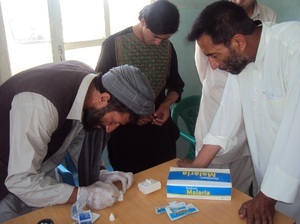Improving malaria diagnosis in Asia
20 June 2014

Clinicians who use rapid diagnostic tests instead of relying on patients’ symptoms are less likely to overprescribe malaria treatment. The tests are also better at detecting fatal forms of malaria, according to research published today in the British Medical Journal.
Researchers from the ACT Consortium conducted a trial in 22 clinics across two areas of Afghanistan to assess which type of diagnosis for malaria resulted in the best treatments for patients with a fever.
They compared clinical diagnosis – where the clinician uses only the patients’ history and symptoms – or microscopy with the use of malaria rapid diagnostic tests (RDTs).
In an area where malaria transmission is low and doctors rely on symptoms to diagnose the disease, only 12% of patients were treated appropriately. This was because clinicians assumed that patients had malaria, when in fact none of them had the disease.
However, when using RDTs, appropriate treatment rose to 65%, leading to many fewer patients being given drugs they did not need.
Informing malaria control in other Asian countries
There have been few studies on malaria diagnosis in Asia, despite more than two billion people being at risk in the region. In most cases, health workers don’t test patients’ blood to identify malaria parasites due to lack of resources.
“The World Health Organization is concentrating very much now on the process of expanding access to parasite-based diagnosis for malaria,” said the lead author, Dr Toby Leslie from the London School of Hygiene & Tropical Medicine. “So we hope that this research will provide insights into the impact that these tools might have in other regions.”
Dr Leslie, who was also project manager for this study, added: “The clinics where we conducted the research are fairly typical primary healthcare clinics of most low-income areas of south Asia, so we think the findings are probably generalizable”.
Targeting drugs to the right type of malaria
In most areas of the world outside Africa where there is malaria, the parasite is made up of two species: Plasmodium falciparum and Plasmodium vivax. Differentiating between the two is an important challenge since they often require different treatments.
The study found that rapid diagnostic tests are much more effective than microscopy at detecting P. falciparum, which is rarer but also more likely to be fatal. Treatment was therefore more accurate, which reduced the wastage of expensive artemisinin-based combination therapy (ACT) and ensured that more patients who needed the drug received it.
However, where malaria is more common, the researchers compared RDTs to blood-smears and found that almost 30% of patients who had a negative test result – with either diagnostic tool – still received antimalarial drugs, which means that these were wasted and patients were given the wrong treatment.
“We would recommend that the introduction of RDTs is done with significant piloting and a series of evaluations to check that the right treatment is given to malaria patients and, importantly, to patients who don’t have malaria but may have other diseases,” the study author advised.
Further information
- Read the paper "Rapid diagnostic tests to improve treatment of malaria and other febrile illnesses: patient randomised effectiveness trial in primary care clinics in Afghanistan" in the British Medical Journal
- Watch the video abstract on the BMJ YouTube channel
- Read the BMJ Editorial on rapid diagnostic tests for malaria
- Learn more about the ACT Consortium research on non-malarial causes of fever
- Watch a video about our research on malaria management by community health workers in Uganda and Afghanistan

